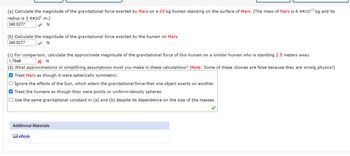Question

Transcribed Image Text:Two rocks collide in outer space. Before the collision, one rock had mass 15 kg and velocity < 4300, -2700, 2600 > m/s. The other rock had mass 10 kg and velocity <
-650, 2200, 3650 > m/s. A 1 kg chunk of the first rock breaks off and sticks to the second rock. After the collision the 14 kg rock has velocity < 1500, 350, 2000 >
m/s. After the collision, what is the velocity of the other rock, whose mass is now 11 kg?
Additional Materials
eBook
m/s

Transcribed Image Text:(a) Calculate the magnitude of the gravitational force exerted by Mars on a 65 kg human standing on the surface of Mars. (The mass of Mars is 6.4×1023 kg and its
radius is 3.4×106 m.)
240.0277
N
(b) Calculate the magnitude of the gravitational force exerted by the human on Mars.
240.0277
N
(c) For comparison, calculate the approximate magnitude of the gravitational force of this human on a similar human who is standing 2.5 meters away.
1.76e8
X N
(d) What approximations or simplifying assumptions must you make in these calculations? (Note: Some of these choices are false because they are wrong physics!)
✔ Treat Mars as though it were spherically symmetric.
Ignore the effects of the Sun, which alters the gravitational force that one object exerts on another.
✔ Treat the humans as though they were points or uniform-density spheres.
Use the same gravitational constant in (a) and (b) despite its dependence on the size of the masses.
Additional Materials
eBook
Expert Solution
This question has been solved!
Explore an expertly crafted, step-by-step solution for a thorough understanding of key concepts.
Step by stepSolved in 2 steps with 1 images

Knowledge Booster
Similar questions
- My wife and I went ice skating. I was traveling at 4.5m/s and she was traveling 2m/s both in the same direction. I have a mass of 95kg, and she has a mass of 70kg. I lose my balance and collide into her and we continue as one body.(a) What is the speed we are traveling after the collision?(b) Was there kinetic energy lost? If so, how much?arrow_forwardA large fish with mass 4.9 kg suddenly accelerates to a velocity 3.3 m/s to the right to gobble up a small fish with mass 0.4 kg swimming also to the right at 0.8 m/s. Immediate after the meal, how fast is the large fish? Assume the large fish didn't swallow much water.arrow_forwardAn ice skating couple are playing in the ice. The 70 kg man gets a good start (6.0 m/s) skating toward the 55 kg woman, who is moving in the same direction at 1.5 m/s. After grabbing her hand and flinging her forward, he is still moving at 1.0 m/s in the same direction. How fast (in m/s) has he managed to get the woman moving?arrow_forward
- An 5,000-kg train car moves to the right at 15 m/sec. It collides with a 7,000-kg parked train car. The cars get stuck together and roll along the track. How fast do they move after the collision?arrow_forward11. Two magnets are sliding towards each other. One of the magnets, which has a mass of 125 grams, is moving in the positive x-direction at a speed of 7.33 m/s. The other magnet, which has a mass of 85.0 grams, is moving in the negative x-direction at a speed of 11.9 m/s. When they collide, they bind together, and move as a single unit. What is the velocity of this single unit immediately after the collision?arrow_forward1. A bowling ball of mass 8.0 kg is traveling at 10 m/s when it strikes a 1.5-kg bowling pin. After being hit by the ball, the pin flies backward (in the direction that the ball was traveling) at 20 m/s while the bail continues in the same direction. What is the velocity of the ball after impact?arrow_forward
- A hungry 3.89 kg fish swimming at 2.43 m/s swallows a 1.25 kg fish that was swimming towards it at 2.3 m/s. What is the final speed in m/s of the formely hungry fisharrow_forwardA mass of m1= 4 kg moving with a velocity of v1=(2 m/s)ˆi (positive x−direction) collides with another mass, m2 moving at v2= (−4 m/s)ˆi (negative x−direction). The masses collide and stick together, moving off with a velocity of v= (−2 m/s)ˆi. What is m2? A)m2= 4 kg B)m2= 8 kg C)m2= 12 kg D)m2= 16 kgarrow_forward23. Please give detailed answer.arrow_forward
- Suppose M1 (1 kg) is moving at 3 m/s in the + x direction. M2 (2 kg) is moving at 3 m/s in the -x direction. If they collide and stick together, what will be their final velocity (in m/s)?arrow_forwardA car of mass 2900 kg collides with a truck of mass 4400 kg, and just after the collision the car and truck slide along, stuck together. The car's velocity just before the collision was < 39, 0, 0> m/s, and the truck's velocity just before the collision was < -17, 0, 15> m/s.(a) What is the velocity of the stuck-together car and truck just after the collision?arrow_forward.arrow_forward
arrow_back_ios
SEE MORE QUESTIONS
arrow_forward_ios